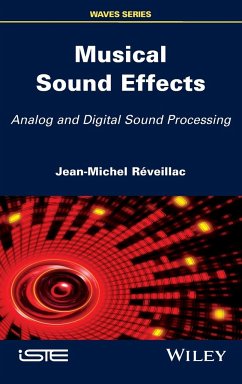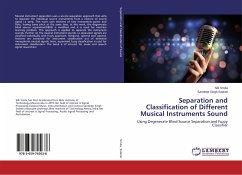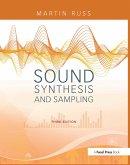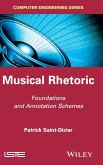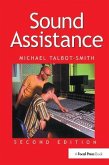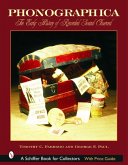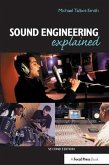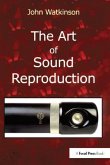- Gebundenes Buch
- Merkliste
- Auf die Merkliste
- Bewerten Bewerten
- Teilen
- Produkt teilen
- Produkterinnerung
- Produkterinnerung
For decades performers, instrumentalists, composers, technicians and sound engineers continue to manipulate sound material. They are trying with more or less success to create, to innovate, improve, enhance, restore or modify the musical message. The sound of distorted guitar of Jimi Hendrix, Pierre Henry's concrete music, Pink Flyod's rock psychedelic, Kraftwerk 's electronic music, Daft Punk and rap T-Pain, have let emerge many effects: reverb, compression, distortion, auto-tune, filter, chorus, phasing, etc. The aim of this book is to introduce and explain these effects and sound treatments by addressing their theoretical and practical aspects.…mehr
Andere Kunden interessierten sich auch für
![Separation and Classification of Different Musical Instruments Sound Separation and Classification of Different Musical Instruments Sound]() Silk SmitaSeparation and Classification of Different Musical Instruments Sound27,99 €
Silk SmitaSeparation and Classification of Different Musical Instruments Sound27,99 €![Sound Synthesis and Sampling Sound Synthesis and Sampling]() Martin RussSound Synthesis and Sampling196,99 €
Martin RussSound Synthesis and Sampling196,99 €![Musical Rhetoric Musical Rhetoric]() Patrick Saint-DizierMusical Rhetoric187,99 €
Patrick Saint-DizierMusical Rhetoric187,99 €![Sound Assistance Sound Assistance]() Michael Talbot-SmithSound Assistance199,99 €
Michael Talbot-SmithSound Assistance199,99 €![Phonographica: The Early History of Recorded Sound Observed Phonographica: The Early History of Recorded Sound Observed]() Timothy C. FabrizioPhonographica: The Early History of Recorded Sound Observed43,99 €
Timothy C. FabrizioPhonographica: The Early History of Recorded Sound Observed43,99 €![Sound Engineering Explained Sound Engineering Explained]() Michael Talbot-SmithSound Engineering Explained199,99 €
Michael Talbot-SmithSound Engineering Explained199,99 €![The Art of Sound Reproduction The Art of Sound Reproduction]() John WatkinsonThe Art of Sound Reproduction262,99 €
John WatkinsonThe Art of Sound Reproduction262,99 €-
-
-
For decades performers, instrumentalists, composers, technicians and sound engineers continue to manipulate sound material. They are trying with more or less success to create, to innovate, improve, enhance, restore or modify the musical message. The sound of distorted guitar of Jimi Hendrix, Pierre Henry's concrete music, Pink Flyod's rock psychedelic, Kraftwerk 's electronic music, Daft Punk and rap T-Pain, have let emerge many effects: reverb, compression, distortion, auto-tune, filter, chorus, phasing, etc. The aim of this book is to introduce and explain these effects and sound treatments by addressing their theoretical and practical aspects.
Hinweis: Dieser Artikel kann nur an eine deutsche Lieferadresse ausgeliefert werden.
Hinweis: Dieser Artikel kann nur an eine deutsche Lieferadresse ausgeliefert werden.
Produktdetails
- Produktdetails
- Verlag: Wiley
- Seitenzahl: 400
- Erscheinungstermin: 7. März 2018
- Englisch
- Abmessung: 240mm x 161mm x 26mm
- Gewicht: 759g
- ISBN-13: 9781786301314
- ISBN-10: 1786301318
- Artikelnr.: 50119656
- Herstellerkennzeichnung
- Libri GmbH
- Europaallee 1
- 36244 Bad Hersfeld
- gpsr@libri.de
- Verlag: Wiley
- Seitenzahl: 400
- Erscheinungstermin: 7. März 2018
- Englisch
- Abmessung: 240mm x 161mm x 26mm
- Gewicht: 759g
- ISBN-13: 9781786301314
- ISBN-10: 1786301318
- Artikelnr.: 50119656
- Herstellerkennzeichnung
- Libri GmbH
- Europaallee 1
- 36244 Bad Hersfeld
- gpsr@libri.de
Jean-Michel Réveillac is a consultant-adviser and lecturer for large companies. He currently teaches at the University of Burgundy, and CNAM in France and at IGA in Morocco.
Foreword xi
About this Book xiii
Introduction xvii
Chapter 1. Notes on the Theory of Sound 1
1.1. Basic concepts 1
1.1.1. What is sound? 1
1.1.2. Intensity 4
1.1.3. Sound pitch 7
1.1.4. Approaching the concept of timbre 8
1.2. The ears 9
1.2.1. How our ears work 9
1.2.2. Fletcher-Munson curves 14
1.2.3. Auditory spatial awareness 15
1.3. The typology of sounds 21
1.3.1. Sounds and periods 21
1.3.2. Simple sounds and complex sounds 22
1.4. Spectral analysis 24
1.4.1. The sound spectrum 24
1.4.2. Sonogram and spectrogram 26
1.5. Timbre 27
1.5.1. Transient phenomena 27
1.5.2. Range 28
1.5.3. Mass of musical objects 30
1.5.4. Classification of sounds 31
1.6. Sound propagation 32
1.6.1. Dispersion 32
1.6.2. Interference 33
1.6.3. Diffraction 35
1.6.4. Reflection 37
1.6.5. Reverberation (reverb) 39
1.6.6. Absorption 39
1.6.7. Refraction 39
1.6.8. The Doppler effect 40
1.6.9. Beats 40
1.7. Conclusion 41
Chapter 2. Audio Playback 43
2.1. History 44
2.2. Dolby playback standards and specifications 48
2.2.1. Dolby Surround encoding and decoding 48
2.2.2. Dolby Stereo 49
2.2.3. Dolby Surround 50
2.2.4. Dolby Surround Pro-Logic 50
2.2.5. Dolby DIGITAL AC-3 51
2.2.6. Dolby Surround EX 52
2.2.7. Dolby Surround Pro-Logic II 52
2.2.8. Dolby Digital Plus 54
2.2.9. Dolby TrueHD 54
2.2.10. Dolby Atmos 55
2.3. DTS encodings 55
2.3.1. DTS 56
2.3.2. DTS Neo 6 56
2.3.3. DTS ES 6.1 57
2.3.4. DTS 96/24 57
2.3.5. DTS HD Master Audio 57
2.3.6. DTS X 58
2.4. Special encodings 58
2.5. SDDS 59
2.6. THX certification 59
2.6.1. THX select and ultracertification 61
2.6.2. THX Ultra 2 certification 61
2.7. Multichannel audio recording 62
2.8. Postproduction and encoding 63
2.9. Multichannel music media: DVD-Audio and SACD 65
2.9.1. DVD-Audio 65
2.9.2. Super Audio CD 67
2.9.3. Comparison of CDs, SACDs and DVD-Audios 69
2.10. Conclusion 69
Chapter 3. Types of Effect 71
3.1. Physical appearance 71
3.1.1. Racks 72
3.1.2. Pedals 74
3.1.3. Software plugins 77
3.2. Audio processing 78
3.3. Conclusion 80
Chapter 4. Filtering Effects 81
4.1. Families of filtering effects 81
4.2. Equalization 84
4.2.1. Frequency bands and ranges 84
4.2.2. Types of equalizer 86
4.2.3. Examples of equalizers 91
4.2.4. Tips for equalizing a mix 94
4.3. Wah-wah 97
4.3.1. History 97
4.3.2. Theory 99
4.3.3. Auto-wah 100
4.3.4. Examples of wah-wah pedals 101
4.4. Crossover 102
4.5. Conclusion 104
Chapter 5. Modulation Effects 105
5.1. Flanger 105
5.1.1. History 105
5.1.2. Theory and parameters 107
5.1.3. Models of flanger 110
5.2. Phaser 111
5.2.1. Examples of phasers 113
5.3. Chorus 115
5.3.1. Examples of chorus 116
5.4. Rotary, univibe or rotovibe. 117
5.4.1. History 118
5.4.2. Theoretical principles 120
5.4.3. Leslie speakers 122
5.4.4. Examples of rotary or univibe pedals 123
5.4.5. Leslie speakers and sound recording 125
5.5. Ring modulation 127
5.5.1. Theoretical principles 127
5.5.2. Examples of ring modulators 129
5.6. Final remarks 130
Chapter 6. Frequency Effects 131
6.1. Vibrato 131
6.1.1. Theoretical principles 132
6.1.2. Settings 132
6.1.3. Examples of vibrato 133
6.2. Transposers 135
6.2.1. Octaver 135
6.2.2. Pitch shifter 137
6.2.3. Harmonizer 139
6.2.4. Auto-Tune 142
6.3. Conclusion 154
Chapter 7. Dynamic Effects 155
7.1. Compression 156
7.1.1. History 156
7.1.2. Parameters of compression 156
7.1.3. Examples of compressors 163
7.1.4. Multiband compressors 166
7.1.5. Guidelines for configuring a compressor 169
7.1.6. Parallel compression 170
7.1.7. Serial compression 171
7.1.8. Compression with a sidechain 171
7.1.9. Some basic compression settings 172
7.1.10. Synchronizing the compressor 175
7.1.11. Using a compressor as a limiter 175
7.2. Expanders 178
7.2.1. Parameters 178
7.2.2. Examples of software expanders 179
7.3. Noise gates 180
7.3.1. Parameters 180
7.3.2. Examples of noise gates 182
7.3.3. Configuring noise gates 184
7.4. De-essers 184
7.4.1. Principle of a de-esser 184
7.4.2. Examples of de-essers 185
7.4.3. Replacing a de-esser with an equalizer and a compressor 186
7.4.4. Configuring a de-esser 186
7.5. Saturation 187
7.5.1. Fuzz 187
7.5.2. Overdrive. 188
7.5.3. Distortion. 188
7.5.4. Examples of equipment dedicated to creating saturation 189
7.6. Exciters and enhancers 192
7.6.1. Examples of exciters 193
7.6.2. Using a sound enhancer 195
7.7. Conclusion 195
Chapter 8. Time Effects 197
8.1. Reverb 197
8.1.1. Theoretical principles 197
8.1.2. History 200
8.1.3. Principles 208
8.1.4. Reverb configuration 219
8.1.5. Recording the IR and deconvolution 227
8.1.6. Studio mixing and reverb 240
8.2. Delay 243
8.2.1. History 243
8.2.2. Types of delay 244
8.2.3. Tips for using delays in the studio 251
8.3. Conclusion 255
Chapter 9. Unclassifiables 257
9.1. Combined effects 257
9.1.1. Fuzzwha 257
9.1.2. Octafuzz 258
9.1.3. Shimmer 259
9.2. Tremolo 262
9.2.1. History 262
9.2.2. Examples of tremolos 264
9.3. Sound restoration tools 266
9.3.1. Declickers 266
9.3.2. Decracklers 267
9.3.3. Denoisers 267
9.3.4. Declippers 267
9.3.5. Debuzzers 268
9.3.6. Examples of restoration tools 268
9.3.7. Final remarks on sound restoration 271
9.4. Loopers 271
9.4.1. Looper connections 272
9.4.2. Examples of looper pedals 274
9.5. Time stretching. 275
9.6. Resampling 276
9.7. Spatialization effects 277
9.8. Conclusion 278
Conclusion 279
Appendices 283
Appendix 1 285
Appendix 2 295
Appendix 3 299
Appendix 4 313
Glossary 319
Bibliography 327
Index 337
About this Book xiii
Introduction xvii
Chapter 1. Notes on the Theory of Sound 1
1.1. Basic concepts 1
1.1.1. What is sound? 1
1.1.2. Intensity 4
1.1.3. Sound pitch 7
1.1.4. Approaching the concept of timbre 8
1.2. The ears 9
1.2.1. How our ears work 9
1.2.2. Fletcher-Munson curves 14
1.2.3. Auditory spatial awareness 15
1.3. The typology of sounds 21
1.3.1. Sounds and periods 21
1.3.2. Simple sounds and complex sounds 22
1.4. Spectral analysis 24
1.4.1. The sound spectrum 24
1.4.2. Sonogram and spectrogram 26
1.5. Timbre 27
1.5.1. Transient phenomena 27
1.5.2. Range 28
1.5.3. Mass of musical objects 30
1.5.4. Classification of sounds 31
1.6. Sound propagation 32
1.6.1. Dispersion 32
1.6.2. Interference 33
1.6.3. Diffraction 35
1.6.4. Reflection 37
1.6.5. Reverberation (reverb) 39
1.6.6. Absorption 39
1.6.7. Refraction 39
1.6.8. The Doppler effect 40
1.6.9. Beats 40
1.7. Conclusion 41
Chapter 2. Audio Playback 43
2.1. History 44
2.2. Dolby playback standards and specifications 48
2.2.1. Dolby Surround encoding and decoding 48
2.2.2. Dolby Stereo 49
2.2.3. Dolby Surround 50
2.2.4. Dolby Surround Pro-Logic 50
2.2.5. Dolby DIGITAL AC-3 51
2.2.6. Dolby Surround EX 52
2.2.7. Dolby Surround Pro-Logic II 52
2.2.8. Dolby Digital Plus 54
2.2.9. Dolby TrueHD 54
2.2.10. Dolby Atmos 55
2.3. DTS encodings 55
2.3.1. DTS 56
2.3.2. DTS Neo 6 56
2.3.3. DTS ES 6.1 57
2.3.4. DTS 96/24 57
2.3.5. DTS HD Master Audio 57
2.3.6. DTS X 58
2.4. Special encodings 58
2.5. SDDS 59
2.6. THX certification 59
2.6.1. THX select and ultracertification 61
2.6.2. THX Ultra 2 certification 61
2.7. Multichannel audio recording 62
2.8. Postproduction and encoding 63
2.9. Multichannel music media: DVD-Audio and SACD 65
2.9.1. DVD-Audio 65
2.9.2. Super Audio CD 67
2.9.3. Comparison of CDs, SACDs and DVD-Audios 69
2.10. Conclusion 69
Chapter 3. Types of Effect 71
3.1. Physical appearance 71
3.1.1. Racks 72
3.1.2. Pedals 74
3.1.3. Software plugins 77
3.2. Audio processing 78
3.3. Conclusion 80
Chapter 4. Filtering Effects 81
4.1. Families of filtering effects 81
4.2. Equalization 84
4.2.1. Frequency bands and ranges 84
4.2.2. Types of equalizer 86
4.2.3. Examples of equalizers 91
4.2.4. Tips for equalizing a mix 94
4.3. Wah-wah 97
4.3.1. History 97
4.3.2. Theory 99
4.3.3. Auto-wah 100
4.3.4. Examples of wah-wah pedals 101
4.4. Crossover 102
4.5. Conclusion 104
Chapter 5. Modulation Effects 105
5.1. Flanger 105
5.1.1. History 105
5.1.2. Theory and parameters 107
5.1.3. Models of flanger 110
5.2. Phaser 111
5.2.1. Examples of phasers 113
5.3. Chorus 115
5.3.1. Examples of chorus 116
5.4. Rotary, univibe or rotovibe. 117
5.4.1. History 118
5.4.2. Theoretical principles 120
5.4.3. Leslie speakers 122
5.4.4. Examples of rotary or univibe pedals 123
5.4.5. Leslie speakers and sound recording 125
5.5. Ring modulation 127
5.5.1. Theoretical principles 127
5.5.2. Examples of ring modulators 129
5.6. Final remarks 130
Chapter 6. Frequency Effects 131
6.1. Vibrato 131
6.1.1. Theoretical principles 132
6.1.2. Settings 132
6.1.3. Examples of vibrato 133
6.2. Transposers 135
6.2.1. Octaver 135
6.2.2. Pitch shifter 137
6.2.3. Harmonizer 139
6.2.4. Auto-Tune 142
6.3. Conclusion 154
Chapter 7. Dynamic Effects 155
7.1. Compression 156
7.1.1. History 156
7.1.2. Parameters of compression 156
7.1.3. Examples of compressors 163
7.1.4. Multiband compressors 166
7.1.5. Guidelines for configuring a compressor 169
7.1.6. Parallel compression 170
7.1.7. Serial compression 171
7.1.8. Compression with a sidechain 171
7.1.9. Some basic compression settings 172
7.1.10. Synchronizing the compressor 175
7.1.11. Using a compressor as a limiter 175
7.2. Expanders 178
7.2.1. Parameters 178
7.2.2. Examples of software expanders 179
7.3. Noise gates 180
7.3.1. Parameters 180
7.3.2. Examples of noise gates 182
7.3.3. Configuring noise gates 184
7.4. De-essers 184
7.4.1. Principle of a de-esser 184
7.4.2. Examples of de-essers 185
7.4.3. Replacing a de-esser with an equalizer and a compressor 186
7.4.4. Configuring a de-esser 186
7.5. Saturation 187
7.5.1. Fuzz 187
7.5.2. Overdrive. 188
7.5.3. Distortion. 188
7.5.4. Examples of equipment dedicated to creating saturation 189
7.6. Exciters and enhancers 192
7.6.1. Examples of exciters 193
7.6.2. Using a sound enhancer 195
7.7. Conclusion 195
Chapter 8. Time Effects 197
8.1. Reverb 197
8.1.1. Theoretical principles 197
8.1.2. History 200
8.1.3. Principles 208
8.1.4. Reverb configuration 219
8.1.5. Recording the IR and deconvolution 227
8.1.6. Studio mixing and reverb 240
8.2. Delay 243
8.2.1. History 243
8.2.2. Types of delay 244
8.2.3. Tips for using delays in the studio 251
8.3. Conclusion 255
Chapter 9. Unclassifiables 257
9.1. Combined effects 257
9.1.1. Fuzzwha 257
9.1.2. Octafuzz 258
9.1.3. Shimmer 259
9.2. Tremolo 262
9.2.1. History 262
9.2.2. Examples of tremolos 264
9.3. Sound restoration tools 266
9.3.1. Declickers 266
9.3.2. Decracklers 267
9.3.3. Denoisers 267
9.3.4. Declippers 267
9.3.5. Debuzzers 268
9.3.6. Examples of restoration tools 268
9.3.7. Final remarks on sound restoration 271
9.4. Loopers 271
9.4.1. Looper connections 272
9.4.2. Examples of looper pedals 274
9.5. Time stretching. 275
9.6. Resampling 276
9.7. Spatialization effects 277
9.8. Conclusion 278
Conclusion 279
Appendices 283
Appendix 1 285
Appendix 2 295
Appendix 3 299
Appendix 4 313
Glossary 319
Bibliography 327
Index 337
Foreword xi
About this Book xiii
Introduction xvii
Chapter 1. Notes on the Theory of Sound 1
1.1. Basic concepts 1
1.1.1. What is sound? 1
1.1.2. Intensity 4
1.1.3. Sound pitch 7
1.1.4. Approaching the concept of timbre 8
1.2. The ears 9
1.2.1. How our ears work 9
1.2.2. Fletcher-Munson curves 14
1.2.3. Auditory spatial awareness 15
1.3. The typology of sounds 21
1.3.1. Sounds and periods 21
1.3.2. Simple sounds and complex sounds 22
1.4. Spectral analysis 24
1.4.1. The sound spectrum 24
1.4.2. Sonogram and spectrogram 26
1.5. Timbre 27
1.5.1. Transient phenomena 27
1.5.2. Range 28
1.5.3. Mass of musical objects 30
1.5.4. Classification of sounds 31
1.6. Sound propagation 32
1.6.1. Dispersion 32
1.6.2. Interference 33
1.6.3. Diffraction 35
1.6.4. Reflection 37
1.6.5. Reverberation (reverb) 39
1.6.6. Absorption 39
1.6.7. Refraction 39
1.6.8. The Doppler effect 40
1.6.9. Beats 40
1.7. Conclusion 41
Chapter 2. Audio Playback 43
2.1. History 44
2.2. Dolby playback standards and specifications 48
2.2.1. Dolby Surround encoding and decoding 48
2.2.2. Dolby Stereo 49
2.2.3. Dolby Surround 50
2.2.4. Dolby Surround Pro-Logic 50
2.2.5. Dolby DIGITAL AC-3 51
2.2.6. Dolby Surround EX 52
2.2.7. Dolby Surround Pro-Logic II 52
2.2.8. Dolby Digital Plus 54
2.2.9. Dolby TrueHD 54
2.2.10. Dolby Atmos 55
2.3. DTS encodings 55
2.3.1. DTS 56
2.3.2. DTS Neo 6 56
2.3.3. DTS ES 6.1 57
2.3.4. DTS 96/24 57
2.3.5. DTS HD Master Audio 57
2.3.6. DTS X 58
2.4. Special encodings 58
2.5. SDDS 59
2.6. THX certification 59
2.6.1. THX select and ultracertification 61
2.6.2. THX Ultra 2 certification 61
2.7. Multichannel audio recording 62
2.8. Postproduction and encoding 63
2.9. Multichannel music media: DVD-Audio and SACD 65
2.9.1. DVD-Audio 65
2.9.2. Super Audio CD 67
2.9.3. Comparison of CDs, SACDs and DVD-Audios 69
2.10. Conclusion 69
Chapter 3. Types of Effect 71
3.1. Physical appearance 71
3.1.1. Racks 72
3.1.2. Pedals 74
3.1.3. Software plugins 77
3.2. Audio processing 78
3.3. Conclusion 80
Chapter 4. Filtering Effects 81
4.1. Families of filtering effects 81
4.2. Equalization 84
4.2.1. Frequency bands and ranges 84
4.2.2. Types of equalizer 86
4.2.3. Examples of equalizers 91
4.2.4. Tips for equalizing a mix 94
4.3. Wah-wah 97
4.3.1. History 97
4.3.2. Theory 99
4.3.3. Auto-wah 100
4.3.4. Examples of wah-wah pedals 101
4.4. Crossover 102
4.5. Conclusion 104
Chapter 5. Modulation Effects 105
5.1. Flanger 105
5.1.1. History 105
5.1.2. Theory and parameters 107
5.1.3. Models of flanger 110
5.2. Phaser 111
5.2.1. Examples of phasers 113
5.3. Chorus 115
5.3.1. Examples of chorus 116
5.4. Rotary, univibe or rotovibe. 117
5.4.1. History 118
5.4.2. Theoretical principles 120
5.4.3. Leslie speakers 122
5.4.4. Examples of rotary or univibe pedals 123
5.4.5. Leslie speakers and sound recording 125
5.5. Ring modulation 127
5.5.1. Theoretical principles 127
5.5.2. Examples of ring modulators 129
5.6. Final remarks 130
Chapter 6. Frequency Effects 131
6.1. Vibrato 131
6.1.1. Theoretical principles 132
6.1.2. Settings 132
6.1.3. Examples of vibrato 133
6.2. Transposers 135
6.2.1. Octaver 135
6.2.2. Pitch shifter 137
6.2.3. Harmonizer 139
6.2.4. Auto-Tune 142
6.3. Conclusion 154
Chapter 7. Dynamic Effects 155
7.1. Compression 156
7.1.1. History 156
7.1.2. Parameters of compression 156
7.1.3. Examples of compressors 163
7.1.4. Multiband compressors 166
7.1.5. Guidelines for configuring a compressor 169
7.1.6. Parallel compression 170
7.1.7. Serial compression 171
7.1.8. Compression with a sidechain 171
7.1.9. Some basic compression settings 172
7.1.10. Synchronizing the compressor 175
7.1.11. Using a compressor as a limiter 175
7.2. Expanders 178
7.2.1. Parameters 178
7.2.2. Examples of software expanders 179
7.3. Noise gates 180
7.3.1. Parameters 180
7.3.2. Examples of noise gates 182
7.3.3. Configuring noise gates 184
7.4. De-essers 184
7.4.1. Principle of a de-esser 184
7.4.2. Examples of de-essers 185
7.4.3. Replacing a de-esser with an equalizer and a compressor 186
7.4.4. Configuring a de-esser 186
7.5. Saturation 187
7.5.1. Fuzz 187
7.5.2. Overdrive. 188
7.5.3. Distortion. 188
7.5.4. Examples of equipment dedicated to creating saturation 189
7.6. Exciters and enhancers 192
7.6.1. Examples of exciters 193
7.6.2. Using a sound enhancer 195
7.7. Conclusion 195
Chapter 8. Time Effects 197
8.1. Reverb 197
8.1.1. Theoretical principles 197
8.1.2. History 200
8.1.3. Principles 208
8.1.4. Reverb configuration 219
8.1.5. Recording the IR and deconvolution 227
8.1.6. Studio mixing and reverb 240
8.2. Delay 243
8.2.1. History 243
8.2.2. Types of delay 244
8.2.3. Tips for using delays in the studio 251
8.3. Conclusion 255
Chapter 9. Unclassifiables 257
9.1. Combined effects 257
9.1.1. Fuzzwha 257
9.1.2. Octafuzz 258
9.1.3. Shimmer 259
9.2. Tremolo 262
9.2.1. History 262
9.2.2. Examples of tremolos 264
9.3. Sound restoration tools 266
9.3.1. Declickers 266
9.3.2. Decracklers 267
9.3.3. Denoisers 267
9.3.4. Declippers 267
9.3.5. Debuzzers 268
9.3.6. Examples of restoration tools 268
9.3.7. Final remarks on sound restoration 271
9.4. Loopers 271
9.4.1. Looper connections 272
9.4.2. Examples of looper pedals 274
9.5. Time stretching. 275
9.6. Resampling 276
9.7. Spatialization effects 277
9.8. Conclusion 278
Conclusion 279
Appendices 283
Appendix 1 285
Appendix 2 295
Appendix 3 299
Appendix 4 313
Glossary 319
Bibliography 327
Index 337
About this Book xiii
Introduction xvii
Chapter 1. Notes on the Theory of Sound 1
1.1. Basic concepts 1
1.1.1. What is sound? 1
1.1.2. Intensity 4
1.1.3. Sound pitch 7
1.1.4. Approaching the concept of timbre 8
1.2. The ears 9
1.2.1. How our ears work 9
1.2.2. Fletcher-Munson curves 14
1.2.3. Auditory spatial awareness 15
1.3. The typology of sounds 21
1.3.1. Sounds and periods 21
1.3.2. Simple sounds and complex sounds 22
1.4. Spectral analysis 24
1.4.1. The sound spectrum 24
1.4.2. Sonogram and spectrogram 26
1.5. Timbre 27
1.5.1. Transient phenomena 27
1.5.2. Range 28
1.5.3. Mass of musical objects 30
1.5.4. Classification of sounds 31
1.6. Sound propagation 32
1.6.1. Dispersion 32
1.6.2. Interference 33
1.6.3. Diffraction 35
1.6.4. Reflection 37
1.6.5. Reverberation (reverb) 39
1.6.6. Absorption 39
1.6.7. Refraction 39
1.6.8. The Doppler effect 40
1.6.9. Beats 40
1.7. Conclusion 41
Chapter 2. Audio Playback 43
2.1. History 44
2.2. Dolby playback standards and specifications 48
2.2.1. Dolby Surround encoding and decoding 48
2.2.2. Dolby Stereo 49
2.2.3. Dolby Surround 50
2.2.4. Dolby Surround Pro-Logic 50
2.2.5. Dolby DIGITAL AC-3 51
2.2.6. Dolby Surround EX 52
2.2.7. Dolby Surround Pro-Logic II 52
2.2.8. Dolby Digital Plus 54
2.2.9. Dolby TrueHD 54
2.2.10. Dolby Atmos 55
2.3. DTS encodings 55
2.3.1. DTS 56
2.3.2. DTS Neo 6 56
2.3.3. DTS ES 6.1 57
2.3.4. DTS 96/24 57
2.3.5. DTS HD Master Audio 57
2.3.6. DTS X 58
2.4. Special encodings 58
2.5. SDDS 59
2.6. THX certification 59
2.6.1. THX select and ultracertification 61
2.6.2. THX Ultra 2 certification 61
2.7. Multichannel audio recording 62
2.8. Postproduction and encoding 63
2.9. Multichannel music media: DVD-Audio and SACD 65
2.9.1. DVD-Audio 65
2.9.2. Super Audio CD 67
2.9.3. Comparison of CDs, SACDs and DVD-Audios 69
2.10. Conclusion 69
Chapter 3. Types of Effect 71
3.1. Physical appearance 71
3.1.1. Racks 72
3.1.2. Pedals 74
3.1.3. Software plugins 77
3.2. Audio processing 78
3.3. Conclusion 80
Chapter 4. Filtering Effects 81
4.1. Families of filtering effects 81
4.2. Equalization 84
4.2.1. Frequency bands and ranges 84
4.2.2. Types of equalizer 86
4.2.3. Examples of equalizers 91
4.2.4. Tips for equalizing a mix 94
4.3. Wah-wah 97
4.3.1. History 97
4.3.2. Theory 99
4.3.3. Auto-wah 100
4.3.4. Examples of wah-wah pedals 101
4.4. Crossover 102
4.5. Conclusion 104
Chapter 5. Modulation Effects 105
5.1. Flanger 105
5.1.1. History 105
5.1.2. Theory and parameters 107
5.1.3. Models of flanger 110
5.2. Phaser 111
5.2.1. Examples of phasers 113
5.3. Chorus 115
5.3.1. Examples of chorus 116
5.4. Rotary, univibe or rotovibe. 117
5.4.1. History 118
5.4.2. Theoretical principles 120
5.4.3. Leslie speakers 122
5.4.4. Examples of rotary or univibe pedals 123
5.4.5. Leslie speakers and sound recording 125
5.5. Ring modulation 127
5.5.1. Theoretical principles 127
5.5.2. Examples of ring modulators 129
5.6. Final remarks 130
Chapter 6. Frequency Effects 131
6.1. Vibrato 131
6.1.1. Theoretical principles 132
6.1.2. Settings 132
6.1.3. Examples of vibrato 133
6.2. Transposers 135
6.2.1. Octaver 135
6.2.2. Pitch shifter 137
6.2.3. Harmonizer 139
6.2.4. Auto-Tune 142
6.3. Conclusion 154
Chapter 7. Dynamic Effects 155
7.1. Compression 156
7.1.1. History 156
7.1.2. Parameters of compression 156
7.1.3. Examples of compressors 163
7.1.4. Multiband compressors 166
7.1.5. Guidelines for configuring a compressor 169
7.1.6. Parallel compression 170
7.1.7. Serial compression 171
7.1.8. Compression with a sidechain 171
7.1.9. Some basic compression settings 172
7.1.10. Synchronizing the compressor 175
7.1.11. Using a compressor as a limiter 175
7.2. Expanders 178
7.2.1. Parameters 178
7.2.2. Examples of software expanders 179
7.3. Noise gates 180
7.3.1. Parameters 180
7.3.2. Examples of noise gates 182
7.3.3. Configuring noise gates 184
7.4. De-essers 184
7.4.1. Principle of a de-esser 184
7.4.2. Examples of de-essers 185
7.4.3. Replacing a de-esser with an equalizer and a compressor 186
7.4.4. Configuring a de-esser 186
7.5. Saturation 187
7.5.1. Fuzz 187
7.5.2. Overdrive. 188
7.5.3. Distortion. 188
7.5.4. Examples of equipment dedicated to creating saturation 189
7.6. Exciters and enhancers 192
7.6.1. Examples of exciters 193
7.6.2. Using a sound enhancer 195
7.7. Conclusion 195
Chapter 8. Time Effects 197
8.1. Reverb 197
8.1.1. Theoretical principles 197
8.1.2. History 200
8.1.3. Principles 208
8.1.4. Reverb configuration 219
8.1.5. Recording the IR and deconvolution 227
8.1.6. Studio mixing and reverb 240
8.2. Delay 243
8.2.1. History 243
8.2.2. Types of delay 244
8.2.3. Tips for using delays in the studio 251
8.3. Conclusion 255
Chapter 9. Unclassifiables 257
9.1. Combined effects 257
9.1.1. Fuzzwha 257
9.1.2. Octafuzz 258
9.1.3. Shimmer 259
9.2. Tremolo 262
9.2.1. History 262
9.2.2. Examples of tremolos 264
9.3. Sound restoration tools 266
9.3.1. Declickers 266
9.3.2. Decracklers 267
9.3.3. Denoisers 267
9.3.4. Declippers 267
9.3.5. Debuzzers 268
9.3.6. Examples of restoration tools 268
9.3.7. Final remarks on sound restoration 271
9.4. Loopers 271
9.4.1. Looper connections 272
9.4.2. Examples of looper pedals 274
9.5. Time stretching. 275
9.6. Resampling 276
9.7. Spatialization effects 277
9.8. Conclusion 278
Conclusion 279
Appendices 283
Appendix 1 285
Appendix 2 295
Appendix 3 299
Appendix 4 313
Glossary 319
Bibliography 327
Index 337

